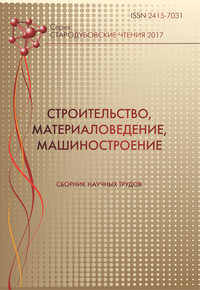Influence of macrostructure of pipe castings from the centrifugal cast steel 40х25н20с2 on the mechanical properties under different temperatures
Keywords:
centrifugal casting, macrostructure, mechanical propertiesAbstract
Abstract. Purpose. Study of the influence of technological factors and macrostructure of centrifugally-cast billets from steel 40H25N20С2 on the mechanilal properties under different temperatures. Methodology. Macrostructure of pipe castings from steel 40H25N20С2 produced by horizontal centrifugal casting machines was analyzed. The influence of parameters of centrifugal casting on the character of macrostructure was investigatedMmechanical tests under different temperatures were carried out. Findings. It was shown the influence of parameters of centrifugal casting and dendritic macrostructure of pipe castings from steel 40H25N20С2 on the mechanilal properties. It was fixed that more propitious is the dispersed transcrystalline macrostructure of pipe castings. The parameters of centrifugal casting ensuring formation of dispersed transcrystalline macrostructure of pipe castings were determined. It was shown the influence of parameters of centrifugal casting and macrostructure on the mechanical properties of pipe castings under different temperatures. Originality. We discuss the processes of macrostructure formation of pipe castings from steel 40H25N20С2 under different conditions of centrifugal casting and their influence on the mechanilal properties. Practical value. The obtained results allow to produce centrifugal castings from steel 40H25N20С2 with raise mechanical and service properties.References
Yudin S. B., Levin M. M., Rozenfeld S. E. Tsentrobezhnoe lite. [Сentrifugal casting] - M.: Mashinostroenie, 1972. – 415 s. http://www.twirpx.com/file/443757/
Stepanov Yu.A., Anuchina M.G., Balandin G.F., Konstantinov L.S. Spetsialnyie vidyi litya.[Special types of casting] – M.: Mashinostroenie, 1970. – 224 s. http://www.twirpx.com/file/1656405/
Sarotovkin D.D. Dendritnaya kristallizatsiya.[Dendritic crystallization] - M. : Metallurgizdat,1953. – 176s. http://www.twirpx.com/file/968019/
Yu.G. Solovev. Tsentrobezhnoe lite - progressivnyiy metod proizvodstva stalnyih trub i trubnyih zagotovok. [Centrifugal casting - advanced method of manufacturing steel tubes and tubular blanks] Sbornik «Proizvodstvo trub» VNITI, 1968. - 303 s. http://search.rsl.ru/ru/record/01006075051
Gubenko S.I.. Baleva Yu.I. Tormozheniye mezhzerennogo razrusheniya tsentrobezhnolitoy stali 40Cr25Ni20Si2 vtorichnymi granitsami. [Inhibition of intergranular failure tsentrobezhnolityh steel 40Х25Н20С2 secondary boundaries] Metal I litye Ukrainy. 2016. №2 (273). s.2-8 http://ptima.kiev.ua/index.php?option=com_content&task=view&id=343&Itemid=68&lang=ru
Gubenko S.I.. Bespalko V.N.. Yurkovskiy V.V.. Baleva Yu.I. Nemetallicheskiye vklyucheniya v tsentrobezhnolitoy stali 40Cr25Ni20Si2. [Non-metallic inclusions in steel tsentrobezhnolityh 40Cr25Ni20Si2]. Metall i litye Ukrainy. 2016. №4. s. 13-17 http://ptima.kiev.ua/index.php?option=com_content&task=view&id=349&Itemid=68&lang=ru
Idelchik I.E. Gidravlicheskoye soprotivleniye. [Hydraulic resistance] - L.: Gosєnergoizda. 1954. – 221s. http://www.twirpx.com/file/881578/
N.V. Rulla. G.M. Samoylov. M.M. Studinskiy «Proizvodstvo trub». [The production of pipes].Sbornik statey po teorii i praktike trubnogo proizvodstva. Moskva. 1961. vypusk 4. http://www.twirpx.com/file/55095/
Gubenko S.I. Fizika razrusheniya staley vblizi nemetallicheskikh vklyucheniy.[Physics of fracture steel near non-metallic inclusions]. Dnepropetrovsk.: NmetAU ITs «Sistemnyye tekhnologii». 2014. – 01s. http://catalog.odnb.odessa.ua/opac/index.php?url=/notices/index/IdNotice:298626/Source:default
Movchan B.A. Granitsy kristallitov v litykh metallakh i splavakh. [The boundaries of the crystallites in cast metals and alloys]. K.. Tekhnika. 1970. 212s. http://www.twirpx.com/file/1055556/
Golikov I.N.. Maslenkov S.B. Dendritnaya likvatsiya v stalyakh i splavakh.[Dendritic liquation in steels and alloys]. M.. Metallurgiya. 1977. 224 s. http://www.twirpx.com/file/1980026/
Saratovkin D.D. Dendritnaya kristallizatsiya. [Dendritic crystallization]. M.. Metallurgizdat. 1957. 125 s. http://www.twirpx.com/file/968019/
Yavoyskiy V.I. Teoriya protsessov proizvodstva stali. [Theory of steel-making processes]. M.. Metallurgizdat. 1963. 820 s. http://ntb.misis.ru:591/OpacUnicode/index.php?url=/notices/index/IdNotice:421394/Source:default
Downloads
Published
Issue
Section
License
Редакція Видання категорично засуджує прояви плагіату в статтях та вживає всіх можливих заходів для його недопущення. Плагіат розглядається як форма порушення авторських прав і наукової етики.
При виявлені у статті більш ніж 25% запозиченого тексту без відповідних посилань та використання лапок, стаття кваліфікується як така, що містить плагіат. У цьому випадку стаття більше не розглядається редакцією, а автор отримує перше попередження.
Автори, в статтях яких повторно виявлено плагіат, не зможуть публікуватися в усіх журналах Видавництва ДВНЗ «Придніпровська державна академія будівництва та архітектури».
Автори, які публікуються у цьому журналі, погоджуються з наступними умовами:
- Автори залишають за собою право на авторство своєї роботи та передають журналу право першої публікації цієї роботи на умовах ліцензії Creative Commons Attribution License, котра дозволяє іншим особам вільно розповсюджувати опубліковану роботу з обов'язковим посиланням на авторів оригінальної роботи та першу публікацію роботи у цьому журналі.
- Автори мають право укладати самостійні додаткові угоди щодо неексклюзивного розповсюдження роботи у тому вигляді, в якому вона була опублікована цим журналом (наприклад, розміщувати роботу в електронному сховищі установи або публікувати у складі монографії), за умови збереження посилання на першу публікацію роботи у цьому журналі.
- Політика журналу дозволяє і заохочує розміщення авторами в мережі Інтернет (наприклад, у сховищах установ або на особистих веб-сайтах) рукопису роботи, як до подання цього рукопису до редакції, так і під час його редакційного опрацювання, оскільки це сприяє виникненню продуктивної наукової дискусії та позитивно позначається на оперативності та динаміці цитування опублікованої роботи (див. The Effect of Open Access).

